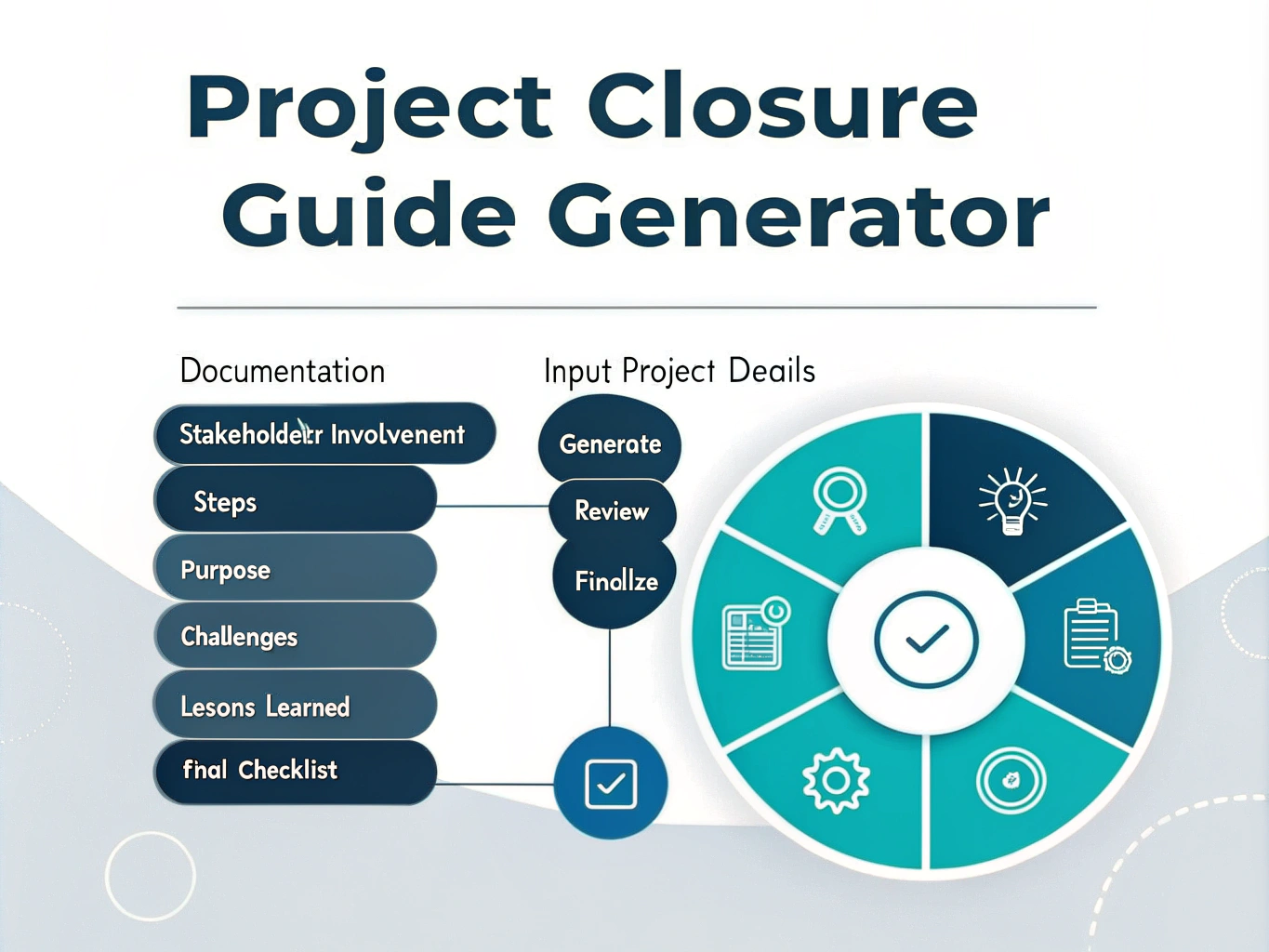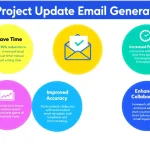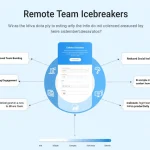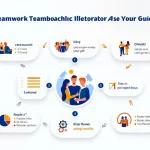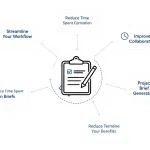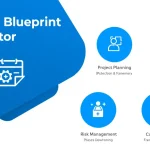Is this tool helpful?
How to Use the Project Closure Guide Generator Effectively
The Project Closure Guide Generator is a powerful tool designed to help project managers and team leaders create comprehensive project closure plans tailored to their specific needs. Here’s how to use it effectively:
- Enter the Project Type (Optional): In the first field, specify the type of project you’re closing. For example, you might enter “Software Development” or “Marketing Campaign Launch.”
- Specify the Project Size (Optional): In the second field, indicate the size of your project. You could enter “Large-scale Enterprise Project” or “Small Team Initiative.”
- Include Industry-Specific Considerations (Optional): In the third field, mention any industry-specific factors that might affect your project closure. For instance, you could input “HIPAA compliance requirements” or “ISO 9001 quality management standards.”
- Generate the Guide: Click the “Generate Project Closure Guide” button to create your customized closure plan.
- Review and Copy: Once generated, review the guide in the results section. You can then use the “Copy to Clipboard” button to easily transfer the content to your preferred document or project management tool.
By providing these optional details, you’ll receive a more tailored project closure guide that addresses your specific project needs and industry requirements.
Understanding the Project Closure Guide Generator: Definition, Purpose, and Benefits
The Project Closure Guide Generator is an innovative tool designed to streamline the process of creating comprehensive project closure plans. It leverages advanced algorithms and best practices in project management to produce customized guides that ensure no critical steps are overlooked during the crucial project closure phase.
Definition
At its core, the Project Closure Guide Generator is a dynamic, web-based tool that synthesizes project management expertise with user-provided information to create tailored project closure guidelines. It takes into account various factors such as project type, size, and industry-specific considerations to generate a detailed roadmap for successfully concluding projects.
Purpose
The primary purpose of this tool is to assist project managers, team leaders, and organizations in effectively closing out projects. It aims to:
- Ensure all project closure activities are systematically addressed
- Provide a structured approach to finalizing project deliverables
- Facilitate the proper documentation of project outcomes and lessons learned
- Guide the release of project resources and formal stakeholder acceptance
- Promote consistency in project closure processes across different projects and teams
Benefits
Utilizing the Project Closure Guide Generator offers numerous benefits to project teams and organizations:
- Time Efficiency: By automating the creation of closure guidelines, the tool saves significant time that would otherwise be spent researching and compiling best practices.
- Customization: The generator takes into account specific project characteristics, ensuring that the guide is relevant and applicable to your unique project context.
- Comprehensive Coverage: The tool ensures that all critical aspects of project closure are addressed, reducing the risk of overlooking important steps.
- Best Practices Integration: The generated guides incorporate industry-standard best practices, promoting professionalism and quality in project closure processes.
- Consistency: By providing a standardized approach to project closure, the tool helps maintain consistency across different projects within an organization.
- Knowledge Transfer: The detailed guides serve as educational tools, helping less experienced team members understand the intricacies of proper project closure.
- Risk Mitigation: By ensuring a thorough closure process, the tool helps mitigate risks associated with incomplete project wrap-ups, such as unresolved issues or missed contractual obligations.
- Stakeholder Satisfaction: A well-executed project closure, guided by the tool’s recommendations, can lead to increased stakeholder satisfaction and improved relationships.
The Importance of Effective Project Closure
Project closure is a critical phase in the project lifecycle that often doesn’t receive the attention it deserves. The Project Closure Guide Generator addresses this gap by emphasizing the significance of proper closure and providing the necessary tools to execute it effectively.
Ensuring Project Success
A project is not truly successful until it’s properly closed. The closure phase is where you:
- Confirm all deliverables have been completed and accepted
- Ensure all project objectives have been met
- Formally release team members and resources
- Archive project documents for future reference
- Celebrate achievements and recognize team contributions
The Project Closure Guide Generator helps ensure all these aspects are systematically addressed, contributing to overall project success.
Facilitating Organizational Learning
One of the key benefits of proper project closure is the opportunity for organizational learning. The generator emphasizes the importance of capturing lessons learned, which can be invaluable for future projects. It provides structured guidance on:
- Conducting post-project reviews
- Documenting successes and challenges
- Identifying areas for improvement
- Sharing insights across the organization
By facilitating this process, the tool contributes to continuous improvement and knowledge management within the organization.
Key Components of the Project Closure Guide
The Project Closure Guide Generator creates comprehensive guides that typically include the following key components:
1. Purpose of Project Closure
This section explains why project closure is crucial and outlines the benefits it brings to the organization and project team. It helps set the context for the closure activities and motivates the team to execute them diligently.
2. Steps in the Project Closure Process
A detailed breakdown of the typical steps involved in closing a project is provided. This includes:
- Finalizing all project activities
- Handing over deliverables to the client or relevant stakeholders
- Releasing project resources (human, financial, and material)
- Obtaining formal acceptance from stakeholders
3. Documentation Requirements
The guide identifies key documents that need to be completed during project closure and explains their significance. This typically includes:
- Project Closure Report
- Lessons Learned Document
- Final Project Performance Report
- Asset Transfer Documents
- Contract Closure Documents
4. Stakeholder Involvement
This section discusses the role of various stakeholders in the project closure process and provides guidance on effectively communicating closure information to them. It may include tips on:
- Conducting closure meetings
- Obtaining formal sign-offs
- Managing expectations during the transition period
5. Challenges and Solutions
The guide highlights common challenges encountered during project closure and proposes practical solutions to overcome them. This might include strategies for:
- Dealing with scope creep during closure
- Managing stakeholder resistance to project closure
- Addressing incomplete deliverables
- Handling budget overruns in the final stages
6. Lessons Learned Process
A crucial component of the guide is the section on capturing and documenting lessons learned. It provides a structured approach to:
- Conducting lessons learned sessions
- Documenting insights effectively
- Categorizing lessons for easy retrieval
- Sharing lessons across the organization
- Incorporating learnings into future projects
7. Final Checklist
The guide concludes with a comprehensive checklist of essential items or tasks that must be completed to ensure a thorough and successful project closure. This serves as a final verification tool to ensure nothing is overlooked.
Customizing the Project Closure Guide for Different Industries
One of the strengths of the Project Closure Guide Generator is its ability to tailor the guide based on industry-specific considerations. Here’s how it adapts to different sectors:
IT and Software Development
For IT projects, the guide might emphasize:
- Software handover procedures
- Data migration and system decommissioning processes
- User acceptance testing documentation
- Intellectual property rights transfer
- Ongoing support and maintenance arrangements
Construction
In the construction industry, the guide could focus on:
- Final inspections and certifications
- Handover of as-built drawings and maintenance manuals
- Warranty documentation
- Site cleanup and demobilization procedures
- Health and safety file compilation
Marketing and Advertising
For marketing projects, the guide might highlight:
- Campaign performance analysis and reporting
- Client debriefing sessions
- Asset archival (e.g., creative materials, market research data)
- Intellectual property rights clarification
- Relationship management for potential future collaborations
Healthcare
In healthcare projects, the guide could emphasize:
- Patient data protection and privacy compliance
- Clinical trial documentation and archiving
- Regulatory submission processes
- Equipment decommissioning and disposal procedures
- Post-implementation monitoring plans
Practical Applications of the Project Closure Guide Generator
To illustrate the versatility and effectiveness of the Project Closure Guide Generator, let’s explore some practical applications across different project types and sizes:
Example 1: Large-Scale ERP Implementation
Consider a multinational corporation implementing a new Enterprise Resource Planning (ERP) system across its global operations. The project closure guide for this scenario might include:
- Detailed data migration verification processes
- Phased system decommissioning plans for legacy systems
- Comprehensive training completion reports for all user groups
- Vendor contract closure and transition to support agreements
- Global compliance verification checklist
The guide would emphasize the importance of ensuring all regional requirements are met and that the transition to the new system is smooth across all locations.
Example 2: Small Business Website Redesign
For a small local business undergoing a website redesign, the project closure guide might focus on:
- Final content approval and sign-off procedures
- SEO performance baseline establishment for future comparison
- Google Analytics and other tracking tool setup verification
- Domain and hosting transition checklist
- Training documentation for website content management
The guide would emphasize the importance of ensuring the business owner is comfortable with managing the new website and that all necessary documentation is provided for future reference.
Example 3: New Product Launch in the Pharmaceutical Industry
For a pharmaceutical company launching a new drug, the project closure guide might include:
- Regulatory approval documentation archival procedures
- Post-market surveillance plan initiation
- Manufacturing scale-up verification
- Sales force training completion reports
- Marketing material compliance checks
- Patent and intellectual property documentation finalization
The guide would emphasize the critical nature of regulatory compliance and the importance of seamless transition from development to ongoing production and sales.
Maximizing the Benefits of the Project Closure Guide Generator
To get the most out of the Project Closure Guide Generator, consider the following best practices:
1. Customize for Your Organization
While the generator provides a solid foundation, consider adapting the guide to align with your organization’s specific processes and terminology. This will increase adoption and effectiveness.
2. Integrate with Project Management Tools
Incorporate the generated closure guide into your existing project management tools and processes. This could involve creating closure-specific tasks in your project management software based on the guide’s recommendations.
3. Use as a Training Tool
Leverage the generated guides as training materials for new project managers or team members. The comprehensive nature of the guides makes them excellent educational resources.
4. Regular Updates
Project management best practices evolve. Regularly update your inputs to the generator to ensure your closure guides reflect the latest industry standards and organizational learnings.
5. Feedback Loop
After using a generated guide to close a project, gather feedback from the team on its effectiveness. Use this information to refine your inputs for future guide generations.
Frequently Asked Questions about the Project Closure Guide Generator
Q1: How long does it take to generate a project closure guide?
A1: The generation process is typically very quick, usually taking less than a minute. However, the time you spend inputting project details and reviewing the generated guide may vary depending on the complexity of your project.
Q2: Can I edit the generated guide?
A2: Yes, the generated guide is provided in a format that allows for easy copying and pasting into your preferred document editor. From there, you can make any necessary adjustments or additions to suit your specific project needs.
Q3: Is the generator suitable for all types of projects?
A3: The Project Closure Guide Generator is designed to be versatile and applicable to a wide range of project types and industries. However, for highly specialized or unusual projects, you may need to supplement the generated guide with additional industry-specific considerations.
Q4: How often should I use the generator?
A4: It’s recommended to use the generator for every project closure. Even if you’re experienced with project closures, the tool can serve as a valuable checklist and may highlight aspects you might otherwise overlook.
Q5: Can the generator help with troubled projects?
A5: Yes, the generator can be particularly useful for troubled projects. It provides a structured approach to closure that can help identify and address lingering issues, ensuring a more complete and satisfactory project conclusion despite earlier challenges.
Q6: Is technical knowledge required to use the generator?
A6: No special technical knowledge is required. The generator is designed to be user-friendly and accessible to anyone involved in project management, regardless of their technical background.
Q7: How does the generator handle different project methodologies?
A7: The generator is designed to be methodology-agnostic, providing closure guidance that can be adapted to various project management approaches, including traditional, Agile, and hybrid methodologies.
Q8: Can the generator help with regulatory compliance?
A8: While the generator includes general best practices that often align with regulatory requirements, it’s important to note that it doesn’t replace the need for specific regulatory knowledge. Users should always ensure compliance with relevant regulations in their industry and region.
By leveraging the Project Closure Guide Generator and following these best practices, project managers can ensure a more thorough, consistent, and effective project closure process, leading to improved project outcomes and organizational learning.
Important Disclaimer
The calculations, results, and content provided by our tools are not guaranteed to be accurate, complete, or reliable. Users are responsible for verifying and interpreting the results. Our content and tools may contain errors, biases, or inconsistencies. We reserve the right to save inputs and outputs from our tools for the purposes of error debugging, bias identification, and performance improvement. External companies providing AI models used in our tools may also save and process data in accordance with their own policies. By using our tools, you consent to this data collection and processing. We reserve the right to limit the usage of our tools based on current usability factors. By using our tools, you acknowledge that you have read, understood, and agreed to this disclaimer. You accept the inherent risks and limitations associated with the use of our tools and services.
